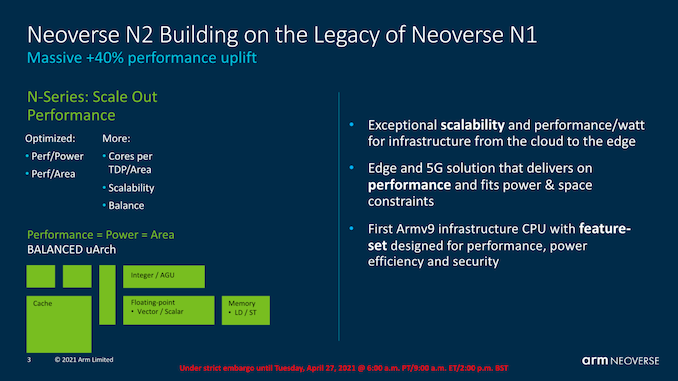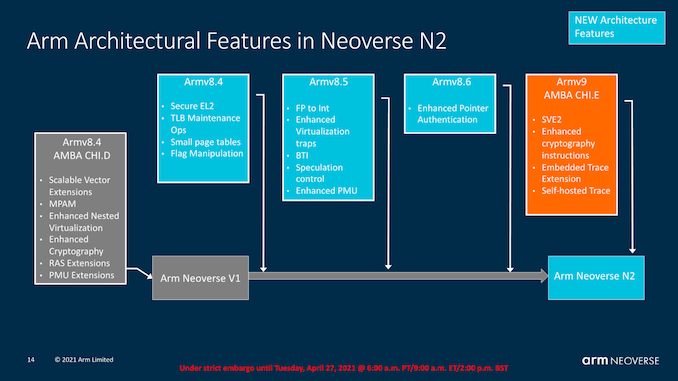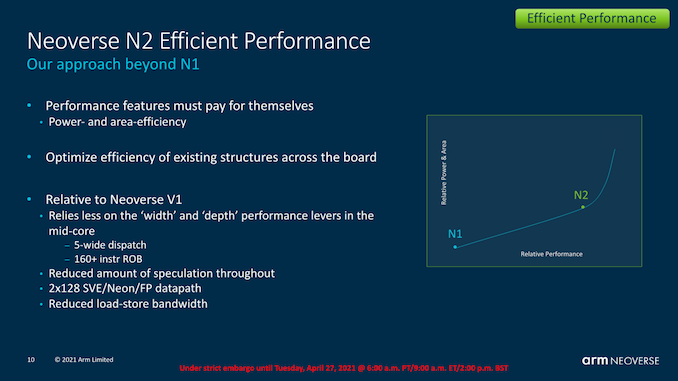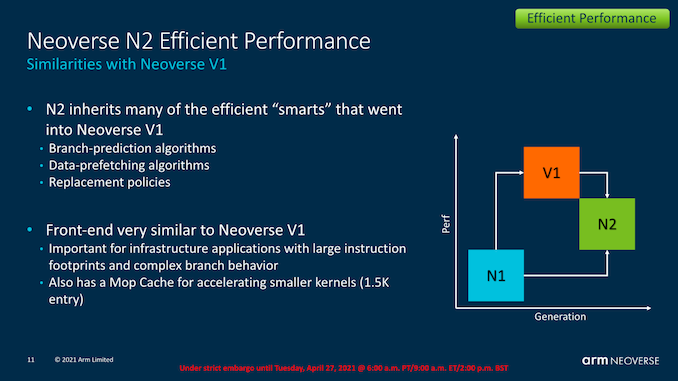Arm Announces Neoverse V1, N2 Platforms & CPUs, CMN-700 Mesh: More Performance, More Cores, More Flexibility
by Andrei Frumusanu on April 27, 2021 9:00 AM EST- Posted in
- CPUs
- Arm
- Servers
- Infrastructure
- Neoverse N1
- Neoverse V1
- Neoverse N2
- CMN-700
The Neoverse N2 µArch: First Armv9 For Enterprise
Moving from the performance oriented Neoverse V1 to the more balanced Neoverse N2 core, we’re seeing a different approach to performance, more akin to the Cortex-A78’s PPA focus versus the X1’s performance focus.
Arm makes note of the “balance” keyword here – the microarchitecture only adopts features and design changes if those changes actually contribute to an increase of the PPA (Performance, Power, Area) equation of the IP. In contrast, the V1 would opt for performance increasing features even if that meant a disproportionate increase in power and area, reducing the total PPA of the design.
Architecturally, the N2 is a newer core than the V1 and takes a higher architectural baseline as the foundation of its capabilities. It’s Arm’s first disclosed Armv9 capable core, including important new features such as SVE2. It’s to be noted that although Arm talked a lot about Armv9 CCA (Confidential Compute Architecture) last month, the Neoverse N2 core does not feature this capability, which is an extension we’re told to expect in future microarchitecture designs.
Arm’s microarchitectural disclosures on the N2 were rather limited compared to the details we’ve seen on the V1. This being a sibling core to the yet undisclosed next generation Cortex-A78 successor, we’ll have to wait a few more months to see exactly what differentiates this newer iteration compared to the Cortex-A78, besides the notable Armv9 features and new SVE2 pipelines.
Arm at least confirms that it’s a narrower microarchitecture in the sense that there’s only a 5-wide dispatch (compared to 8-wide in the V1), and the design features 2x128b native SVE2 and NEON pipelines.
The company states that the new design should still achieve an impressive +40% increase in IPC compared to the Neoverse N1, which is actually substantial given the fact that we’re promised only a linear increase in power and area.
In terms of “smarts”, or better said, microarchitectural innovations, the N2 is a super-set of the V1, just with a more conservative approach to block and structure sizes.
System side features, on top of MPMM and DT, PDP, or Performance Defined Power Management is a feature newer to the N2 that promises to vary the CPU’s microarchitectural features depending on workloads, in order to reduce power consumption without impacting performance. I imagine here that we’re talking about smarter workload dependent clock-gating of microarchitectural features, for example narrowing of the execution resources in low-IPC workloads.

















95 Comments
View All Comments
Oxford Guy - Tuesday, April 27, 2021 - link
‘Fast-forward to 2021, the Neoverse N1 design today employed in designs such as the Ampere Altra is still competitive, or beating the newest generation AMD or Intel designs – a situation that which a few years ago seemed anything but farfetched.’Hmm... That last bit is odd. Either it’s just ‘farfetched’ or it’s ‘expected’.
eastcoast_pete - Tuesday, April 27, 2021 - link
Yes, those slides look very promising; now eagerly awaiting an eventual test of one or two of these in a actual silicone. I guess then we'll see how they measure up.mode_13h - Tuesday, April 27, 2021 - link
Silicone - From Wikipedia, the free encyclopediaNot to be confused with the chemical element silicon.
A silicone or polysiloxane is a polymer made up of siloxane (−R2Si−O−SiR2−, where R = organic group). They are typically colorless, oils or rubber-like substances. Silicones are used in sealants, adhesives, lubricants, medicine, cooking utensils, and thermal and electrical insulation.
eastcoast_pete - Thursday, April 29, 2021 - link
I'll have to take this up with auto-correct. It keeps changing silicon to silicone. Now that I forced it again to leave silicon alone (for the umpteenth time), maybe it will stop (:Mondozai - Tuesday, April 27, 2021 - link
Fantastic overview by Andrew. AT's most underrated reporter. Hopefully he gets more responsibility to cover more things in the future.Linustechtips12#6900xt - Tuesday, April 27, 2021 - link
AGREEDdotjaz - Tuesday, April 27, 2021 - link
Good, finally confirmed N2 is in fact ARMv9 as suspected. Now we'll just have to wait and see how the new mobile counterparts are. Hopefully we'll see some real improvements.It'll be interesting to see how small the new low power v9 core is given that it has to have a 128b SVE2 pipeline instead of 2x64b NEON.
mode_13h - Wednesday, April 28, 2021 - link
> finally confirmed N2 is in fact ARMv9 as suspected.> Now we'll just have to wait and see how the new mobile counterparts are.
> Hopefully we'll see some real improvements.
The data presented on N2 doesn't give me much hope that v9 changed much, besides the feature baseline. I was hoping for something slightly revolutionary, but it's certainly not that.
dotjaz - Thursday, April 29, 2021 - link
> hoping for something slightly revolutionaryWe've known for a couple of years ARMv9 is just ARMv8.x rebased. Your hopes weren't realistic to begin with. Besides, what "revolutionary" features would you expect ISAs to include? Can oyu name one? ARMv8.5a+SVE2 already has everything you need to design an excellent and efficient uarch. Why re-invent the wheel just for the sake of it?
mode_13h - Thursday, April 29, 2021 - link
> We've known for a couple of years ARMv9 is just ARMv8.x rebased.You knew this according to where? It's one thing to assume that, and clearly it wasn't an unreasonable assumption, but it's another thing to *know* it. So, how did you *know* it?
> Besides, what "revolutionary" features would you expect ISAs to include? Can oyu name one?
It's a fair question. Generally speaking, anything that would help improve efficiency. Maybe things like scheduling hints or maybe some kind of tags to indicate memory writes that are thread-private and terminal reads. Just some examples, off the top of my head.
> ARMv8.5a+SVE2 already has everything you need to design an excellent and efficient uarch.
The issue I see is that IPC and efficiency gains are going to become ever more hard-won, so there needs to be some more creativity in redefining the SW/HW interface to unlock further gains. ARMv9 is going to be with us for probably another decade and it could end up having to compete with yet-to-be-identified alternatives like maybe RISC VI or something completely out of left-field. So, I see it as a wasted opportunity. A pragmatic decision, for sure, but a little disappointing.